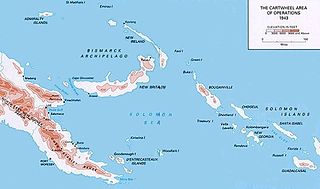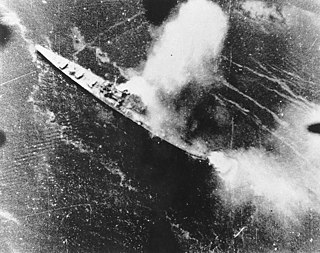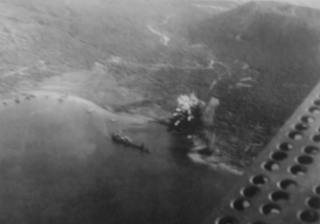
The Asiatic-Pacific Theater, was the theater of operations of U.S. forces during World War II in the Pacific War during 1941–45. From mid-1942 until the end of the war in 1945, there were two U.S. operational commands in the Pacific. The Pacific Ocean Areas (POA), divided into the Central Pacific Area, the North Pacific Area and the South Pacific Area, were commanded by Admiral Chester W. Nimitz, Commander-in-Chief Pacific Ocean Areas. The South West Pacific Area (SWPA) was commanded by General Douglas MacArthur, Supreme Allied Commander South West Pacific Area. During 1945, the United States added the United States Strategic Air Forces in the Pacific, commanded by General Carl A. Spaatz.

New Britain is the largest island in the Bismarck Archipelago of Papua New Guinea. It is separated from the island of New Guinea by the Dampier and Vitiaz Straits and from New Ireland by St. George's Channel. The main towns of New Britain are Rabaul/Kokopo and Kimbe. The island is roughly the size of Taiwan. While the island was part of German New Guinea, it was named Neupommern.

Rabaul is a township in East New Britain province, on the island of New Britain, in the country of Papua New Guinea. It lies about 60 kilometres to the east of the island of New Guinea. Rabaul was the provincial capital and most important settlement in the province until it was destroyed in 1994 by falling ash of a volcanic eruption in its harbor.
This is a list of aviation-related events from 1943:

Operation Cartwheel (1943–1944) was a major military operation for the Allies in the Pacific theatre of World War II. Cartwheel was an operation aimed at neutralising the major Japanese base at Rabaul. The operation was directed by the Supreme Allied Commander in the South West Pacific Area (SWPA), General Douglas MacArthur, whose forces had advanced along the northeast coast of New Guinea and occupied nearby islands. Allied forces from the Pacific Ocean Areas command, under Admiral Chester W. Nimitz, advanced through the Solomon Islands toward Bougainville. The Allied forces involved were from Australia, the Netherlands, New Zealand, the US and various Pacific Islands.

The Battle of the Bismarck Sea took place in the South West Pacific Area (SWPA) during World War II when aircraft of the U.S. Fifth Air Force and the Royal Australian Air Force (RAAF) attacked a Japanese convoy carrying troops to Lae, New Guinea. Most of the Japanese task force was destroyed, and Japanese troop losses were heavy.

The Allies of World War II conducted an air attack upon a cruiser force at the major Japanese base of Rabaul in November 1943. In response to the Allied invasion of Bougainville, the Japanese had brought a strong cruiser force down from Truk, their major naval base in the Caroline Islands about 800 miles north of Rabaul, to Rabaul in preparation for a night engagement against the Allied supply and support shipping. Allied carrier- and land-based planes attacked the Japanese ships, airfields, and port facilities on the island of New Britain to protect the Allied amphibious invasion of Bougainville. As a result of the Rabaul raids, the Japanese naval forces could no longer threaten the landings. The success of the raid began to change the strongly held belief that carrier-based air forces could not challenge land-based air forces.

USS Wilson (DD-408), a Benham-class destroyer, was the only ship of the United States Navy to be named for Charles Wilson, a seaman in the Union Navy during the American Civil War.

The Solomon Islands campaign was a major campaign of the Pacific War of World War II. The campaign began with Japanese landings and occupation of several areas in the British Solomon Islands and Bougainville, in the Territory of New Guinea, during the first six months of 1942. The Japanese occupied these locations and began the construction of several naval and air bases with the goals of protecting the flank of the Japanese offensive in New Guinea, establishing a security barrier for the major Japanese base at Rabaul on New Britain, and providing bases for interdicting supply lines between the Allied powers of the United States and Australia and New Zealand.

The New Guinea campaign of the Pacific War lasted from January 1942 until the end of the war in August 1945. During the initial phase in early 1942, the Empire of Japan invaded the Australian-administered territories of the New Guinea Mandate and Papua and overran western New Guinea, which was a part of the Netherlands East Indies. During the second phase, lasting from late 1942 until the Japanese surrender, the Allies—consisting primarily of Australian and US forces—cleared the Japanese first from Papua, then the Mandate and finally from the Dutch colony.

Sendai was a Sendai-class light cruiser in the Imperial Japanese Navy. She was named after the Sendai River in southern Kyūshū. Sendai was the lead ship of the three vessels completed in her class of light cruisers, and like other vessels of her class, she was intended for use as the flagship of a destroyer flotilla.
The Bombing of Rabaul in February and March 1942 occurred when Allied forces launched counter-attacks against the Empire of Japan base at Rabaul, Papua New Guinea. Rabaul had been captured by the Japanese during the Battle of Rabaul in late January.

Operation Dexterity was a military operation, part of Operation Cartwheel in the South West Pacific Area (SWPA) for the Allies in the Pacific theater of World War II. The operation was directed by the Supreme Allied Commander in the SWPA, General Douglas MacArthur. Dexterity included amphibious landings at Arawe on 15 December 1943, and Cape Gloucester on 26 December 1943 in the northwest of New Britain, the capture of the Imperial Japanese held Tuluvu aerodrome on the 30 December 1943 and the amphibious landing at Saidor on 2 January 1944. The operation ended on 10 February 1944.

The Japanese destroyer Mochizuki was one of twelve Mutsuki-class destroyers, built for the Imperial Japanese Navy (IJN) during the 1920s. During the Pacific War, she participated in the Battle of Wake Island in December 1941 and the occupations of New Guinea and the Solomon Islands in early 1942.

Simpson Harbour is a sheltered harbour of Blanche Bay, on the Gazelle Peninsula in the extreme north of New Britain. The harbour is named after Captain Cortland Simpson, who surveyed the bay while in command of HMS Blanche in 1872. The former capital city of Rabaul is on its shores.

Rabaul is a town in Eastern New Britain, Papua New Guinea. Japanese forces landed on Rabaul on 23 February 1942, capturing it in February of that year. The former Australian territory was transformed into a major Japanese naval and air installation. It was heavily relied on by the Japanese, and was used as a launching point for Japanese reinforcements to New Guinea and Guadalcanal. Throughout the Solomons Campaign, neutralizing Rabaul became the primary objective of the Allied effort in the Solomons.
















